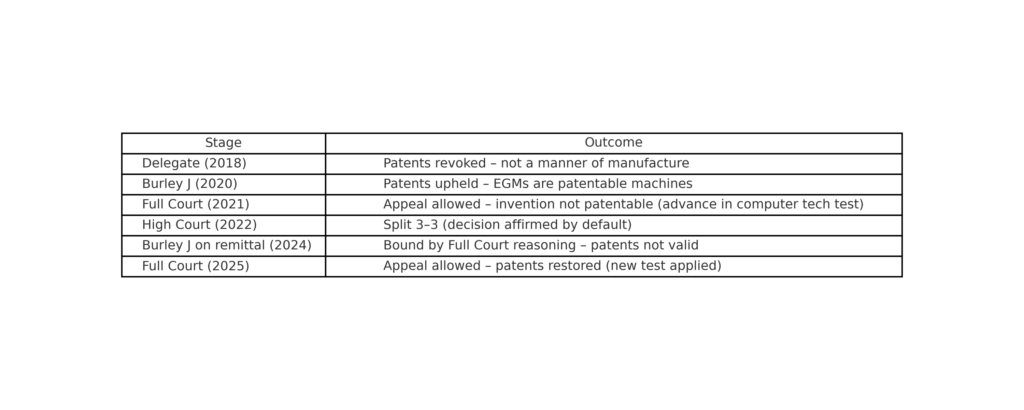Aristocrat’s Jackpot: Full Court Revives Gaming Machine Patents
 When does a slot machine cross the line from an abstract idea to a patentable invention?
When does a slot machine cross the line from an abstract idea to a patentable invention?
After years of litigation, remittals, and even a 3–3 deadlock in the High Court, the Full Federal Court has finally tipped the balance in Aristocrat’s favour.
🎰 The Long Spin
Aristocrat has been fighting since 2018 to keep its patents over electronic gaming machines (EGMs) with “configurable symbols” — feature games that change play dynamics and prize allocation. The Commissioner argued these were just abstract rules of a game dressed up in software. Aristocrat said they were genuine machines of a particular construction that yielded a new and useful result.
The case bounced through:
-
Delegate (2018): patents revoked.
-
Burley J (2020): Aristocrat wins.
-
Full Court (2021): Aristocrat loses (majority invents “advance in computer technology” test).
-
High Court (2022): split 3–3, affirming the Full Court’s result by default under Judiciary Act s 23(2)(a).
-
Remittal (2024): Burley J reluctantly applies Full Court reasoning against Aristocrat.
 Cue the latest appeal.
Cue the latest appeal.
⚖️ The Precedent Puzzle
The Full Court (Beach, Rofe & Jackman JJ) confronted a thorny problem: should it stick to its own 2021 reasoning when the High Court had unanimously rejected that reasoning, even though no majority emerged?
The answer: No.
-
Only majority or unanimous High Court views are binding.
-
But the High Court’s unanimous criticism provided a “compelling reason” to abandon the earlier Full Court approach.
-
The Court found “constructive error” — not blaming Burley J, but recognising the law had to move on.
🖥️ Rethinking “Manner of Manufacture”
The Court reframed the test for computer-implemented inventions:
-
Not patentable: an abstract idea manipulated on a computer.
-
Patentable: an abstract idea implemented on a computer in a way that creates an artificial state of affairs and useful result.
Applying this, Aristocrat’s claim 1 was patentable — and by extension, so were the dependent claims across its four patents. The EGMs weren’t just abstract gaming rules. They were machines, purpose-built to operate in a particular way.
💡 Why It Matters
-
For patentees: This revives hope for computer-implemented inventions beyond “pure software” where technical implementation creates a new device or process.
-
For examiners: IP Australia may need to recalibrate examination practice on software-related patents — the “advance in computer technology” yardstick is gone.
-
For practitioners: This is a case study in how precedent, process, and patents collide. The High Court’s split didn’t end the story — it forced the Full Court to resolve it.
🚀 Takeaway
The Full Court has effectively reset the slot reels. Aristocrat’s EGMs are back in play, and the scope of patentable computer-implemented inventions in Australia looks a little brighter.
Sometimes the house doesn’t win.